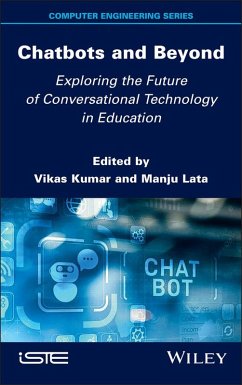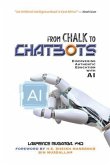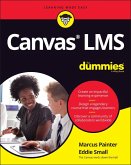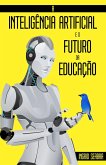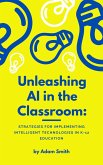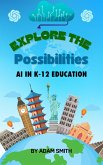Chatbots and Beyond (eBook, ePUB)
Exploring the Future of Conversational Technology in Education
Redaktion: Kumar, Vikas; Lata, Manju
142,99 €
142,99 €
inkl. MwSt.
Sofort per Download lieferbar

0 °P sammeln
142,99 €
Als Download kaufen

142,99 €
inkl. MwSt.
Sofort per Download lieferbar

0 °P sammeln
Jetzt verschenken
Alle Infos zum eBook verschenken
142,99 €
inkl. MwSt.
Sofort per Download lieferbar
Alle Infos zum eBook verschenken

0 °P sammeln
Chatbots and Beyond (eBook, ePUB)
Exploring the Future of Conversational Technology in Education
Redaktion: Kumar, Vikas; Lata, Manju
- Format: ePub
- Merkliste
- Auf die Merkliste
- Bewerten Bewerten
- Teilen
- Produkt teilen
- Produkterinnerung
- Produkterinnerung

Bitte loggen Sie sich zunächst in Ihr Kundenkonto ein oder registrieren Sie sich bei
bücher.de, um das eBook-Abo tolino select nutzen zu können.
Hier können Sie sich einloggen
Hier können Sie sich einloggen
Sie sind bereits eingeloggt. Klicken Sie auf 2. tolino select Abo, um fortzufahren.

Bitte loggen Sie sich zunächst in Ihr Kundenkonto ein oder registrieren Sie sich bei bücher.de, um das eBook-Abo tolino select nutzen zu können.
Chatbots and Beyond provides an innovative analysis of the transformative prospective of conversational technology in the field of education. It reveals the numerous advantages of integrating chatbots into an educational environment and identifies the obstacles in their perfect integration.
This book explores how these technologies can reform teaching and learning experiences, modify learning paths, and streamline administrative processes by using real-world examples and case studies. Rapid developments in artificial intelligence and its implementation in education have also raised many…mehr
- Geräte: eReader
- mit Kopierschutz
- eBook Hilfe
- Größe: 9.8MB
Andere Kunden interessierten sich auch für
![Chatbots and Beyond (eBook, PDF) Chatbots and Beyond (eBook, PDF)]() Chatbots and Beyond (eBook, PDF)142,99 €
Chatbots and Beyond (eBook, PDF)142,99 €![From Chalk to Chatbots (eBook, ePUB) From Chalk to Chatbots (eBook, ePUB)]() Lawrence MugangaFrom Chalk to Chatbots (eBook, ePUB)3,99 €
Lawrence MugangaFrom Chalk to Chatbots (eBook, ePUB)3,99 €![Blackboard For Dummies (eBook, ePUB) Blackboard For Dummies (eBook, ePUB)]() Howie SouthworthBlackboard For Dummies (eBook, ePUB)16,99 €
Howie SouthworthBlackboard For Dummies (eBook, ePUB)16,99 €![Canvas LMS For Dummies (eBook, ePUB) Canvas LMS For Dummies (eBook, ePUB)]() Marcus PainterCanvas LMS For Dummies (eBook, ePUB)16,99 €
Marcus PainterCanvas LMS For Dummies (eBook, ePUB)16,99 €![A Inteligência Artificial e o Futuro da Educação (eBook, ePUB) A Inteligência Artificial e o Futuro da Educação (eBook, ePUB)]() Ingrid SeabraA Inteligência Artificial e o Futuro da Educação (eBook, ePUB)13,99 €
Ingrid SeabraA Inteligência Artificial e o Futuro da Educação (eBook, ePUB)13,99 €![Unleashing AI in the Classroom: Strategies for Implementing Intelligent Technologies in K-12 Education (AI in K-12 Education) (eBook, ePUB) Unleashing AI in the Classroom: Strategies for Implementing Intelligent Technologies in K-12 Education (AI in K-12 Education) (eBook, ePUB)]() Adam SmithUnleashing AI in the Classroom: Strategies for Implementing Intelligent Technologies in K-12 Education (AI in K-12 Education) (eBook, ePUB)4,99 €
Adam SmithUnleashing AI in the Classroom: Strategies for Implementing Intelligent Technologies in K-12 Education (AI in K-12 Education) (eBook, ePUB)4,99 €![Exploring the Possibilities: AI in K12 Education (AI in K-12 Education) (eBook, ePUB) Exploring the Possibilities: AI in K12 Education (AI in K-12 Education) (eBook, ePUB)]() Adam SmithExploring the Possibilities: AI in K12 Education (AI in K-12 Education) (eBook, ePUB)4,99 €
Adam SmithExploring the Possibilities: AI in K12 Education (AI in K-12 Education) (eBook, ePUB)4,99 €-
-
-
Chatbots and Beyond provides an innovative analysis of the transformative prospective of conversational technology in the field of education. It reveals the numerous advantages of integrating chatbots into an educational environment and identifies the obstacles in their perfect integration.
This book explores how these technologies can reform teaching and learning experiences, modify learning paths, and streamline administrative processes by using real-world examples and case studies. Rapid developments in artificial intelligence and its implementation in education have also raised many eyebrows. With millennial students practicing the application of AI on a large scale, it has become important to harness its power for student life cycle integration. With the educational landscape promptly developing, this book makes a strong case for embracing conversational technology as a cornerstone of future-focused educational methods, and serves as a complete guide for researchers, educators and administrators, proposing practical advice and techniques for utilizing chatbots to create a more productive, efficient and engaging learning environment.
This book explores how these technologies can reform teaching and learning experiences, modify learning paths, and streamline administrative processes by using real-world examples and case studies. Rapid developments in artificial intelligence and its implementation in education have also raised many eyebrows. With millennial students practicing the application of AI on a large scale, it has become important to harness its power for student life cycle integration. With the educational landscape promptly developing, this book makes a strong case for embracing conversational technology as a cornerstone of future-focused educational methods, and serves as a complete guide for researchers, educators and administrators, proposing practical advice and techniques for utilizing chatbots to create a more productive, efficient and engaging learning environment.
Dieser Download kann aus rechtlichen Gründen nur mit Rechnungsadresse in D ausgeliefert werden.
Produktdetails
- Produktdetails
- Verlag: John Wiley & Sons
- Seitenzahl: 455
- Erscheinungstermin: 20. Oktober 2025
- Englisch
- ISBN-13: 9781394411276
- Artikelnr.: 75731600
- Verlag: John Wiley & Sons
- Seitenzahl: 455
- Erscheinungstermin: 20. Oktober 2025
- Englisch
- ISBN-13: 9781394411276
- Artikelnr.: 75731600
- Herstellerkennzeichnung Die Herstellerinformationen sind derzeit nicht verfügbar.
Vikas Kumar works at the Central University of Haryana, India, and is Visiting Professor at the IIM Indore and University of Northern Iowa, USA. Manju Lata works as Associate Professor at Chandigarh University, Mohali, India. Her areas of research include artificial intelligence, cloud computing, Big Data analytics and Internet of Things (IoT).
Foreword xiii
Tuan Hung VU
Preface xv
Vikas KUMAR and Manju LATA
Acknowledgements xxi
Vikas KUMAR and Manju LATA
Chapter 1 Nurturing an Inquisitive Mind in the Era of All-Knowing Chatbots
1
Ikbal MAULANA
1.1 Introduction 1
1.2 Technological cognitive enhancement 3
1.3 From endless distraction to cognitive erosion 4
1.4 Fundamental differences between chatbots and humans 7
1.5 What we can know that chatbots cannot 11
1.6 Using chatbots to cultivate critical thinking 13
1.7 Conclusion 16
1.8 References 17
Chapter 2 Artificial Intelligence (AI) in Education 23
Tiara Nur ANISAH and Andika ANDIKA
2.1 Introduction 23
2.2 Basic concepts of artificial intelligence in education 24
2.2.1 Definition of artificial intelligence in education 25
2.2.2 History and evolution of AI in education 25
2.2.3 Categories and types of AI used in education 26
2.3 Implementation of AI in education 27
2.3.1 AI in adaptive learning 27
2.3.2 AI in the writing of a scientific journal 28
2.3.3 AI in assessment 30
2.4 Opportunities and impact of AI in education 32
2.4.1 Opportunities and benefits of AI to improve the quality of education
32
2.4.2 Impact of AI in education 32
2.4.3 Digital divide and accessibility 34
2.5 Case studies of AI implementation in various educational institutions
35
2.6 Recommendations for AI development in education 36
2.7 Conclusion 37
2.8 References 38
Chapter 3 AI and Higher Education 41
Mandakini PARUTHI, Sonam RANI, Sailaja BOHARA, Gaurav GUPTA and Amitabh
BHARGAVA
3.1 Introduction 41
3.2 Defining AI 42
3.3 Need for AI in higher education 43
3.4 Research methodology 43
3.5 Discussion 54
3.6 Implications 54
3.7 Conclusion 55
3.8 References 56
Chapter 4 Chatbot Technologies in Digital Entrepreneurship Education for
Adults 61
Thomas FOTIADIS, Ioanna THEOPHILOU, Evangelia VANEZI, Christos METTOURIS
and George Angelos PAPADOPOULOS
4.1 Introduction 61
4.2 Literature review 62
4.3 Development of a chatbot learning environment 66
4.3.1 Teachers 67
4.3.2 Learners 69
4.3.3 Multilingual 70
4.3.4 Learning modules 71
4.3.5 Courses content and quizzes 72
4.4 Methodology 74
4.4.1 Post-design phase and pilot implementation 74
4.4.2 Pilot study 74
4.4.3 Target group 75
4.4.4 Procedure 75
4.5 Results 75
4.5.1 Quantitative data 75
4.5.2 Qualitative data 77
4.6 Discussion 78
4.7 Conclusion 79
4.8 Future work 80
4.9 Acknowledgments 82
4.10 References 82
Chapter 5 Role of Chatbots as Virtual Tutors in LMS 85
Shilpi CHAKRAVARTY, Mahesh Chandra JOSHI and Iti GAUR
5.1 Introduction 85
5.1.1 Virtual tutors 87
5.2 Definition and role of virtual tutors in modern education 88
5.3 Virtual tutors and learning management systems 90
5.4 Designing an effective chatbot tutor 92
5.4.1 Key features and capabilities of a chatbot tutor 93
5.5 Chatbot tutors versus human tutors 94
5.6 Challenges in implementing chatbots as virtual tutors 96
5.7 The future of chatbot tutors in LMSs 97
5.8 Conclusion 99
5.9 References 100
Chapter 6 Pre-Class Learning in a Flipped Classroom and the Role of Chatbot
103
Sandhya RAI and Vy Ngoc LE HO
6.1 Introduction 103
6.1.1 Pre-class learning 105
6.2 Pre-class learning: importance, roles and methods 106
6.3 Pre-class learning chatbots 109
6.3.1 Types of chatbots 109
6.3.2 Role of the chatbot in pre-class learning 111
6.3.3 Examples of merger of chatbot and flipped classroom 113
6.4 Challenges of integrating AI chatbots into flipped learning 114
6.5 Conclusion 115
6.6 References 116
Chapter 7 Leveraging Chatbots in Management Education: Enhancing LMS
Integration and Flipped Classroom Models 121
Arunava DALAL and Subhajit BHATTACHARYA
7.1 Introduction 121
7.2 Literature review and hypothesis development 123
7.2.1 Flipped classrooms 123
7.2.2 Learning management system 123
7.2.3 Institute readiness 124
7.2.4 Students' attitudes 125
7.2.5 Pedagogical design 125
7.2.6 Academic outcomes 126
7.3 Theoretical framework 126
7.4 Methodology 127
7.5 Findings 128
7.6 Discussion 132
7.7 Conclusion 134
7.7.1 Implications 134
7.7.2 Limitations and future research directions 135
7.8 References 135
Chapter 8 An Analysis of the Quality of Technology Integration in Learning
Management Systems and Its Impact on Teaching Performance 141
FAISOL and Diah NURDIWATY
8.1 Introduction 142
8.2 Literature review and hypothesis 143
8.2.1 The impact of PEU on enhancing academic performance 143
8.2.2 The function of user engagement as a mediating factor 143
8.2.3 The impact of TIQ on enhancing academic performance 144
8.2.4 The function of user engagement as a mediating factor 144
8.2.5 The impact of resource access on enhancing academic performance 145
8.2.6 The mediating role of user engagement in academic performance 146
8.3 Method 148
8.4 Results 149
8.4.1 The measurement model 149
8.4.2 Results of convergent validity and reliability 149
8.4.3 Discriminant validity 151
8.4.4 The structural model 153
8.5 Discussion 157
8.5.1 PEU and academic performance 157
8.5.2 User engagement as a mediator between PEU and academic performance
159
8.5.3 Relationship between TIQ and academic performance improvement 160
8.5.4 The role of user engagement in mediating TIQ and academic performance
162
8.5.5 Access to resources and improvement in academic performance 163
8.5.6 User engagement as a mediator between access to resources and
academic performance 164
8.6 References 165
Chapter 9 The 4IR Paradox: Navigating Autonomy and Regulation in Higher
Education 171
Linda PAUL and Ravinder RENA
9.1 Introduction 171
9.2 Literature review 175
9.2.1 Conceptual framework 177
9.2.2 Emerging concepts 177
9.2.3 Introducing relations between conceptions 177
9.2.4 Critical evaluation 178
9.3 Methodology 179
9.3.1 Study population and sampling 179
9.3.2 Data analyzed using NVivo 180
9.4 Findings 181
9.4.1 In what ways do academic institutions utilize their autonomy to
leverage new innovative 4IR technologies? 181
9.4.2 What are the main regulatory challenges about the adoption of 4IR
technologies by HEI? 182
9.4.3 When it comes to conflict between regulation and autonomy, which
strategies do universities use? 183
9.4.4 What virtuous and/or vicious circles does the 4IR paradox create for
higher education institutions to transform society? 184
9.5 Conclusion 185
9.6 References 188
Chapter 10 AI-Driven Chatbots: Enhancing Educational Experiences Through
Data Analytics 193
Jyoti ARORA, Charnpreet KAUR, Puneet KAUR, Anupam MITTAL and Manju LATA
10.1 Introduction 194
10.2 Literature review 195
10.3 Understanding chatbot interactions: data collection 198
10.4 Gaining insights from chatbot data 201
10.5 Identifying trends, patterns and user segmentation 202
10.6 Challenges and best practices 203
10.7 Future trends and conclusions in chatbot analytics 205
10.8 References 208
Chapter 11 A Chatbot-integrated Deep Learning Approach for Rice Leaf
Disease Detection in the Mekong Delta Region of Vietnam 211
Huu-Hoa NGUYEN, Van-Kiet VO and Thai-Nghe NGUYEN
11.1 Introduction 211
11.2 Related work 213
11.3 System architecture 216
11.4 Rice leaf disease detection component 217
11.4.1 Data collection 217
11.4.2 Data preprocessing 219
11.4.3 Deep learning model configurations 220
11.5 Chatbot component 222
11.5.1 Data collection and preprocessing 222
11.5.2 Rasa framework 224
11.6 Experimental analysis 225
11.6.1 Computational environment and evaluation metrics 225
11.6.2 Deep learning model performance 225
11.6.3 Chatbot creation 230
11.7 Conclusion and perspectives 235
11.8 References 237
Chapter 12 Opportunities, Limitations and Challenges of EDA Playground and
ChatGPT Regarding Verification: A Case Study on Testbench Failures 241
Joel Gonçalves DE OLIVEIRA and Marcio Eduardo KREUTZ
12.1 Introduction 241
12.2 Testbench and software testing 242
12.3 The case of EDA Playground 244
12.4 Using ChatGPT 254
12.5 Comparative analysis 256
12.6 Conclusion 258
12.7 References 259
List of Authors 261
Index 265
Tuan Hung VU
Preface xv
Vikas KUMAR and Manju LATA
Acknowledgements xxi
Vikas KUMAR and Manju LATA
Chapter 1 Nurturing an Inquisitive Mind in the Era of All-Knowing Chatbots
1
Ikbal MAULANA
1.1 Introduction 1
1.2 Technological cognitive enhancement 3
1.3 From endless distraction to cognitive erosion 4
1.4 Fundamental differences between chatbots and humans 7
1.5 What we can know that chatbots cannot 11
1.6 Using chatbots to cultivate critical thinking 13
1.7 Conclusion 16
1.8 References 17
Chapter 2 Artificial Intelligence (AI) in Education 23
Tiara Nur ANISAH and Andika ANDIKA
2.1 Introduction 23
2.2 Basic concepts of artificial intelligence in education 24
2.2.1 Definition of artificial intelligence in education 25
2.2.2 History and evolution of AI in education 25
2.2.3 Categories and types of AI used in education 26
2.3 Implementation of AI in education 27
2.3.1 AI in adaptive learning 27
2.3.2 AI in the writing of a scientific journal 28
2.3.3 AI in assessment 30
2.4 Opportunities and impact of AI in education 32
2.4.1 Opportunities and benefits of AI to improve the quality of education
32
2.4.2 Impact of AI in education 32
2.4.3 Digital divide and accessibility 34
2.5 Case studies of AI implementation in various educational institutions
35
2.6 Recommendations for AI development in education 36
2.7 Conclusion 37
2.8 References 38
Chapter 3 AI and Higher Education 41
Mandakini PARUTHI, Sonam RANI, Sailaja BOHARA, Gaurav GUPTA and Amitabh
BHARGAVA
3.1 Introduction 41
3.2 Defining AI 42
3.3 Need for AI in higher education 43
3.4 Research methodology 43
3.5 Discussion 54
3.6 Implications 54
3.7 Conclusion 55
3.8 References 56
Chapter 4 Chatbot Technologies in Digital Entrepreneurship Education for
Adults 61
Thomas FOTIADIS, Ioanna THEOPHILOU, Evangelia VANEZI, Christos METTOURIS
and George Angelos PAPADOPOULOS
4.1 Introduction 61
4.2 Literature review 62
4.3 Development of a chatbot learning environment 66
4.3.1 Teachers 67
4.3.2 Learners 69
4.3.3 Multilingual 70
4.3.4 Learning modules 71
4.3.5 Courses content and quizzes 72
4.4 Methodology 74
4.4.1 Post-design phase and pilot implementation 74
4.4.2 Pilot study 74
4.4.3 Target group 75
4.4.4 Procedure 75
4.5 Results 75
4.5.1 Quantitative data 75
4.5.2 Qualitative data 77
4.6 Discussion 78
4.7 Conclusion 79
4.8 Future work 80
4.9 Acknowledgments 82
4.10 References 82
Chapter 5 Role of Chatbots as Virtual Tutors in LMS 85
Shilpi CHAKRAVARTY, Mahesh Chandra JOSHI and Iti GAUR
5.1 Introduction 85
5.1.1 Virtual tutors 87
5.2 Definition and role of virtual tutors in modern education 88
5.3 Virtual tutors and learning management systems 90
5.4 Designing an effective chatbot tutor 92
5.4.1 Key features and capabilities of a chatbot tutor 93
5.5 Chatbot tutors versus human tutors 94
5.6 Challenges in implementing chatbots as virtual tutors 96
5.7 The future of chatbot tutors in LMSs 97
5.8 Conclusion 99
5.9 References 100
Chapter 6 Pre-Class Learning in a Flipped Classroom and the Role of Chatbot
103
Sandhya RAI and Vy Ngoc LE HO
6.1 Introduction 103
6.1.1 Pre-class learning 105
6.2 Pre-class learning: importance, roles and methods 106
6.3 Pre-class learning chatbots 109
6.3.1 Types of chatbots 109
6.3.2 Role of the chatbot in pre-class learning 111
6.3.3 Examples of merger of chatbot and flipped classroom 113
6.4 Challenges of integrating AI chatbots into flipped learning 114
6.5 Conclusion 115
6.6 References 116
Chapter 7 Leveraging Chatbots in Management Education: Enhancing LMS
Integration and Flipped Classroom Models 121
Arunava DALAL and Subhajit BHATTACHARYA
7.1 Introduction 121
7.2 Literature review and hypothesis development 123
7.2.1 Flipped classrooms 123
7.2.2 Learning management system 123
7.2.3 Institute readiness 124
7.2.4 Students' attitudes 125
7.2.5 Pedagogical design 125
7.2.6 Academic outcomes 126
7.3 Theoretical framework 126
7.4 Methodology 127
7.5 Findings 128
7.6 Discussion 132
7.7 Conclusion 134
7.7.1 Implications 134
7.7.2 Limitations and future research directions 135
7.8 References 135
Chapter 8 An Analysis of the Quality of Technology Integration in Learning
Management Systems and Its Impact on Teaching Performance 141
FAISOL and Diah NURDIWATY
8.1 Introduction 142
8.2 Literature review and hypothesis 143
8.2.1 The impact of PEU on enhancing academic performance 143
8.2.2 The function of user engagement as a mediating factor 143
8.2.3 The impact of TIQ on enhancing academic performance 144
8.2.4 The function of user engagement as a mediating factor 144
8.2.5 The impact of resource access on enhancing academic performance 145
8.2.6 The mediating role of user engagement in academic performance 146
8.3 Method 148
8.4 Results 149
8.4.1 The measurement model 149
8.4.2 Results of convergent validity and reliability 149
8.4.3 Discriminant validity 151
8.4.4 The structural model 153
8.5 Discussion 157
8.5.1 PEU and academic performance 157
8.5.2 User engagement as a mediator between PEU and academic performance
159
8.5.3 Relationship between TIQ and academic performance improvement 160
8.5.4 The role of user engagement in mediating TIQ and academic performance
162
8.5.5 Access to resources and improvement in academic performance 163
8.5.6 User engagement as a mediator between access to resources and
academic performance 164
8.6 References 165
Chapter 9 The 4IR Paradox: Navigating Autonomy and Regulation in Higher
Education 171
Linda PAUL and Ravinder RENA
9.1 Introduction 171
9.2 Literature review 175
9.2.1 Conceptual framework 177
9.2.2 Emerging concepts 177
9.2.3 Introducing relations between conceptions 177
9.2.4 Critical evaluation 178
9.3 Methodology 179
9.3.1 Study population and sampling 179
9.3.2 Data analyzed using NVivo 180
9.4 Findings 181
9.4.1 In what ways do academic institutions utilize their autonomy to
leverage new innovative 4IR technologies? 181
9.4.2 What are the main regulatory challenges about the adoption of 4IR
technologies by HEI? 182
9.4.3 When it comes to conflict between regulation and autonomy, which
strategies do universities use? 183
9.4.4 What virtuous and/or vicious circles does the 4IR paradox create for
higher education institutions to transform society? 184
9.5 Conclusion 185
9.6 References 188
Chapter 10 AI-Driven Chatbots: Enhancing Educational Experiences Through
Data Analytics 193
Jyoti ARORA, Charnpreet KAUR, Puneet KAUR, Anupam MITTAL and Manju LATA
10.1 Introduction 194
10.2 Literature review 195
10.3 Understanding chatbot interactions: data collection 198
10.4 Gaining insights from chatbot data 201
10.5 Identifying trends, patterns and user segmentation 202
10.6 Challenges and best practices 203
10.7 Future trends and conclusions in chatbot analytics 205
10.8 References 208
Chapter 11 A Chatbot-integrated Deep Learning Approach for Rice Leaf
Disease Detection in the Mekong Delta Region of Vietnam 211
Huu-Hoa NGUYEN, Van-Kiet VO and Thai-Nghe NGUYEN
11.1 Introduction 211
11.2 Related work 213
11.3 System architecture 216
11.4 Rice leaf disease detection component 217
11.4.1 Data collection 217
11.4.2 Data preprocessing 219
11.4.3 Deep learning model configurations 220
11.5 Chatbot component 222
11.5.1 Data collection and preprocessing 222
11.5.2 Rasa framework 224
11.6 Experimental analysis 225
11.6.1 Computational environment and evaluation metrics 225
11.6.2 Deep learning model performance 225
11.6.3 Chatbot creation 230
11.7 Conclusion and perspectives 235
11.8 References 237
Chapter 12 Opportunities, Limitations and Challenges of EDA Playground and
ChatGPT Regarding Verification: A Case Study on Testbench Failures 241
Joel Gonçalves DE OLIVEIRA and Marcio Eduardo KREUTZ
12.1 Introduction 241
12.2 Testbench and software testing 242
12.3 The case of EDA Playground 244
12.4 Using ChatGPT 254
12.5 Comparative analysis 256
12.6 Conclusion 258
12.7 References 259
List of Authors 261
Index 265
Foreword xiii
Tuan Hung VU
Preface xv
Vikas KUMAR and Manju LATA
Acknowledgements xxi
Vikas KUMAR and Manju LATA
Chapter 1 Nurturing an Inquisitive Mind in the Era of All-Knowing Chatbots
1
Ikbal MAULANA
1.1 Introduction 1
1.2 Technological cognitive enhancement 3
1.3 From endless distraction to cognitive erosion 4
1.4 Fundamental differences between chatbots and humans 7
1.5 What we can know that chatbots cannot 11
1.6 Using chatbots to cultivate critical thinking 13
1.7 Conclusion 16
1.8 References 17
Chapter 2 Artificial Intelligence (AI) in Education 23
Tiara Nur ANISAH and Andika ANDIKA
2.1 Introduction 23
2.2 Basic concepts of artificial intelligence in education 24
2.2.1 Definition of artificial intelligence in education 25
2.2.2 History and evolution of AI in education 25
2.2.3 Categories and types of AI used in education 26
2.3 Implementation of AI in education 27
2.3.1 AI in adaptive learning 27
2.3.2 AI in the writing of a scientific journal 28
2.3.3 AI in assessment 30
2.4 Opportunities and impact of AI in education 32
2.4.1 Opportunities and benefits of AI to improve the quality of education
32
2.4.2 Impact of AI in education 32
2.4.3 Digital divide and accessibility 34
2.5 Case studies of AI implementation in various educational institutions
35
2.6 Recommendations for AI development in education 36
2.7 Conclusion 37
2.8 References 38
Chapter 3 AI and Higher Education 41
Mandakini PARUTHI, Sonam RANI, Sailaja BOHARA, Gaurav GUPTA and Amitabh
BHARGAVA
3.1 Introduction 41
3.2 Defining AI 42
3.3 Need for AI in higher education 43
3.4 Research methodology 43
3.5 Discussion 54
3.6 Implications 54
3.7 Conclusion 55
3.8 References 56
Chapter 4 Chatbot Technologies in Digital Entrepreneurship Education for
Adults 61
Thomas FOTIADIS, Ioanna THEOPHILOU, Evangelia VANEZI, Christos METTOURIS
and George Angelos PAPADOPOULOS
4.1 Introduction 61
4.2 Literature review 62
4.3 Development of a chatbot learning environment 66
4.3.1 Teachers 67
4.3.2 Learners 69
4.3.3 Multilingual 70
4.3.4 Learning modules 71
4.3.5 Courses content and quizzes 72
4.4 Methodology 74
4.4.1 Post-design phase and pilot implementation 74
4.4.2 Pilot study 74
4.4.3 Target group 75
4.4.4 Procedure 75
4.5 Results 75
4.5.1 Quantitative data 75
4.5.2 Qualitative data 77
4.6 Discussion 78
4.7 Conclusion 79
4.8 Future work 80
4.9 Acknowledgments 82
4.10 References 82
Chapter 5 Role of Chatbots as Virtual Tutors in LMS 85
Shilpi CHAKRAVARTY, Mahesh Chandra JOSHI and Iti GAUR
5.1 Introduction 85
5.1.1 Virtual tutors 87
5.2 Definition and role of virtual tutors in modern education 88
5.3 Virtual tutors and learning management systems 90
5.4 Designing an effective chatbot tutor 92
5.4.1 Key features and capabilities of a chatbot tutor 93
5.5 Chatbot tutors versus human tutors 94
5.6 Challenges in implementing chatbots as virtual tutors 96
5.7 The future of chatbot tutors in LMSs 97
5.8 Conclusion 99
5.9 References 100
Chapter 6 Pre-Class Learning in a Flipped Classroom and the Role of Chatbot
103
Sandhya RAI and Vy Ngoc LE HO
6.1 Introduction 103
6.1.1 Pre-class learning 105
6.2 Pre-class learning: importance, roles and methods 106
6.3 Pre-class learning chatbots 109
6.3.1 Types of chatbots 109
6.3.2 Role of the chatbot in pre-class learning 111
6.3.3 Examples of merger of chatbot and flipped classroom 113
6.4 Challenges of integrating AI chatbots into flipped learning 114
6.5 Conclusion 115
6.6 References 116
Chapter 7 Leveraging Chatbots in Management Education: Enhancing LMS
Integration and Flipped Classroom Models 121
Arunava DALAL and Subhajit BHATTACHARYA
7.1 Introduction 121
7.2 Literature review and hypothesis development 123
7.2.1 Flipped classrooms 123
7.2.2 Learning management system 123
7.2.3 Institute readiness 124
7.2.4 Students' attitudes 125
7.2.5 Pedagogical design 125
7.2.6 Academic outcomes 126
7.3 Theoretical framework 126
7.4 Methodology 127
7.5 Findings 128
7.6 Discussion 132
7.7 Conclusion 134
7.7.1 Implications 134
7.7.2 Limitations and future research directions 135
7.8 References 135
Chapter 8 An Analysis of the Quality of Technology Integration in Learning
Management Systems and Its Impact on Teaching Performance 141
FAISOL and Diah NURDIWATY
8.1 Introduction 142
8.2 Literature review and hypothesis 143
8.2.1 The impact of PEU on enhancing academic performance 143
8.2.2 The function of user engagement as a mediating factor 143
8.2.3 The impact of TIQ on enhancing academic performance 144
8.2.4 The function of user engagement as a mediating factor 144
8.2.5 The impact of resource access on enhancing academic performance 145
8.2.6 The mediating role of user engagement in academic performance 146
8.3 Method 148
8.4 Results 149
8.4.1 The measurement model 149
8.4.2 Results of convergent validity and reliability 149
8.4.3 Discriminant validity 151
8.4.4 The structural model 153
8.5 Discussion 157
8.5.1 PEU and academic performance 157
8.5.2 User engagement as a mediator between PEU and academic performance
159
8.5.3 Relationship between TIQ and academic performance improvement 160
8.5.4 The role of user engagement in mediating TIQ and academic performance
162
8.5.5 Access to resources and improvement in academic performance 163
8.5.6 User engagement as a mediator between access to resources and
academic performance 164
8.6 References 165
Chapter 9 The 4IR Paradox: Navigating Autonomy and Regulation in Higher
Education 171
Linda PAUL and Ravinder RENA
9.1 Introduction 171
9.2 Literature review 175
9.2.1 Conceptual framework 177
9.2.2 Emerging concepts 177
9.2.3 Introducing relations between conceptions 177
9.2.4 Critical evaluation 178
9.3 Methodology 179
9.3.1 Study population and sampling 179
9.3.2 Data analyzed using NVivo 180
9.4 Findings 181
9.4.1 In what ways do academic institutions utilize their autonomy to
leverage new innovative 4IR technologies? 181
9.4.2 What are the main regulatory challenges about the adoption of 4IR
technologies by HEI? 182
9.4.3 When it comes to conflict between regulation and autonomy, which
strategies do universities use? 183
9.4.4 What virtuous and/or vicious circles does the 4IR paradox create for
higher education institutions to transform society? 184
9.5 Conclusion 185
9.6 References 188
Chapter 10 AI-Driven Chatbots: Enhancing Educational Experiences Through
Data Analytics 193
Jyoti ARORA, Charnpreet KAUR, Puneet KAUR, Anupam MITTAL and Manju LATA
10.1 Introduction 194
10.2 Literature review 195
10.3 Understanding chatbot interactions: data collection 198
10.4 Gaining insights from chatbot data 201
10.5 Identifying trends, patterns and user segmentation 202
10.6 Challenges and best practices 203
10.7 Future trends and conclusions in chatbot analytics 205
10.8 References 208
Chapter 11 A Chatbot-integrated Deep Learning Approach for Rice Leaf
Disease Detection in the Mekong Delta Region of Vietnam 211
Huu-Hoa NGUYEN, Van-Kiet VO and Thai-Nghe NGUYEN
11.1 Introduction 211
11.2 Related work 213
11.3 System architecture 216
11.4 Rice leaf disease detection component 217
11.4.1 Data collection 217
11.4.2 Data preprocessing 219
11.4.3 Deep learning model configurations 220
11.5 Chatbot component 222
11.5.1 Data collection and preprocessing 222
11.5.2 Rasa framework 224
11.6 Experimental analysis 225
11.6.1 Computational environment and evaluation metrics 225
11.6.2 Deep learning model performance 225
11.6.3 Chatbot creation 230
11.7 Conclusion and perspectives 235
11.8 References 237
Chapter 12 Opportunities, Limitations and Challenges of EDA Playground and
ChatGPT Regarding Verification: A Case Study on Testbench Failures 241
Joel Gonçalves DE OLIVEIRA and Marcio Eduardo KREUTZ
12.1 Introduction 241
12.2 Testbench and software testing 242
12.3 The case of EDA Playground 244
12.4 Using ChatGPT 254
12.5 Comparative analysis 256
12.6 Conclusion 258
12.7 References 259
List of Authors 261
Index 265
Tuan Hung VU
Preface xv
Vikas KUMAR and Manju LATA
Acknowledgements xxi
Vikas KUMAR and Manju LATA
Chapter 1 Nurturing an Inquisitive Mind in the Era of All-Knowing Chatbots
1
Ikbal MAULANA
1.1 Introduction 1
1.2 Technological cognitive enhancement 3
1.3 From endless distraction to cognitive erosion 4
1.4 Fundamental differences between chatbots and humans 7
1.5 What we can know that chatbots cannot 11
1.6 Using chatbots to cultivate critical thinking 13
1.7 Conclusion 16
1.8 References 17
Chapter 2 Artificial Intelligence (AI) in Education 23
Tiara Nur ANISAH and Andika ANDIKA
2.1 Introduction 23
2.2 Basic concepts of artificial intelligence in education 24
2.2.1 Definition of artificial intelligence in education 25
2.2.2 History and evolution of AI in education 25
2.2.3 Categories and types of AI used in education 26
2.3 Implementation of AI in education 27
2.3.1 AI in adaptive learning 27
2.3.2 AI in the writing of a scientific journal 28
2.3.3 AI in assessment 30
2.4 Opportunities and impact of AI in education 32
2.4.1 Opportunities and benefits of AI to improve the quality of education
32
2.4.2 Impact of AI in education 32
2.4.3 Digital divide and accessibility 34
2.5 Case studies of AI implementation in various educational institutions
35
2.6 Recommendations for AI development in education 36
2.7 Conclusion 37
2.8 References 38
Chapter 3 AI and Higher Education 41
Mandakini PARUTHI, Sonam RANI, Sailaja BOHARA, Gaurav GUPTA and Amitabh
BHARGAVA
3.1 Introduction 41
3.2 Defining AI 42
3.3 Need for AI in higher education 43
3.4 Research methodology 43
3.5 Discussion 54
3.6 Implications 54
3.7 Conclusion 55
3.8 References 56
Chapter 4 Chatbot Technologies in Digital Entrepreneurship Education for
Adults 61
Thomas FOTIADIS, Ioanna THEOPHILOU, Evangelia VANEZI, Christos METTOURIS
and George Angelos PAPADOPOULOS
4.1 Introduction 61
4.2 Literature review 62
4.3 Development of a chatbot learning environment 66
4.3.1 Teachers 67
4.3.2 Learners 69
4.3.3 Multilingual 70
4.3.4 Learning modules 71
4.3.5 Courses content and quizzes 72
4.4 Methodology 74
4.4.1 Post-design phase and pilot implementation 74
4.4.2 Pilot study 74
4.4.3 Target group 75
4.4.4 Procedure 75
4.5 Results 75
4.5.1 Quantitative data 75
4.5.2 Qualitative data 77
4.6 Discussion 78
4.7 Conclusion 79
4.8 Future work 80
4.9 Acknowledgments 82
4.10 References 82
Chapter 5 Role of Chatbots as Virtual Tutors in LMS 85
Shilpi CHAKRAVARTY, Mahesh Chandra JOSHI and Iti GAUR
5.1 Introduction 85
5.1.1 Virtual tutors 87
5.2 Definition and role of virtual tutors in modern education 88
5.3 Virtual tutors and learning management systems 90
5.4 Designing an effective chatbot tutor 92
5.4.1 Key features and capabilities of a chatbot tutor 93
5.5 Chatbot tutors versus human tutors 94
5.6 Challenges in implementing chatbots as virtual tutors 96
5.7 The future of chatbot tutors in LMSs 97
5.8 Conclusion 99
5.9 References 100
Chapter 6 Pre-Class Learning in a Flipped Classroom and the Role of Chatbot
103
Sandhya RAI and Vy Ngoc LE HO
6.1 Introduction 103
6.1.1 Pre-class learning 105
6.2 Pre-class learning: importance, roles and methods 106
6.3 Pre-class learning chatbots 109
6.3.1 Types of chatbots 109
6.3.2 Role of the chatbot in pre-class learning 111
6.3.3 Examples of merger of chatbot and flipped classroom 113
6.4 Challenges of integrating AI chatbots into flipped learning 114
6.5 Conclusion 115
6.6 References 116
Chapter 7 Leveraging Chatbots in Management Education: Enhancing LMS
Integration and Flipped Classroom Models 121
Arunava DALAL and Subhajit BHATTACHARYA
7.1 Introduction 121
7.2 Literature review and hypothesis development 123
7.2.1 Flipped classrooms 123
7.2.2 Learning management system 123
7.2.3 Institute readiness 124
7.2.4 Students' attitudes 125
7.2.5 Pedagogical design 125
7.2.6 Academic outcomes 126
7.3 Theoretical framework 126
7.4 Methodology 127
7.5 Findings 128
7.6 Discussion 132
7.7 Conclusion 134
7.7.1 Implications 134
7.7.2 Limitations and future research directions 135
7.8 References 135
Chapter 8 An Analysis of the Quality of Technology Integration in Learning
Management Systems and Its Impact on Teaching Performance 141
FAISOL and Diah NURDIWATY
8.1 Introduction 142
8.2 Literature review and hypothesis 143
8.2.1 The impact of PEU on enhancing academic performance 143
8.2.2 The function of user engagement as a mediating factor 143
8.2.3 The impact of TIQ on enhancing academic performance 144
8.2.4 The function of user engagement as a mediating factor 144
8.2.5 The impact of resource access on enhancing academic performance 145
8.2.6 The mediating role of user engagement in academic performance 146
8.3 Method 148
8.4 Results 149
8.4.1 The measurement model 149
8.4.2 Results of convergent validity and reliability 149
8.4.3 Discriminant validity 151
8.4.4 The structural model 153
8.5 Discussion 157
8.5.1 PEU and academic performance 157
8.5.2 User engagement as a mediator between PEU and academic performance
159
8.5.3 Relationship between TIQ and academic performance improvement 160
8.5.4 The role of user engagement in mediating TIQ and academic performance
162
8.5.5 Access to resources and improvement in academic performance 163
8.5.6 User engagement as a mediator between access to resources and
academic performance 164
8.6 References 165
Chapter 9 The 4IR Paradox: Navigating Autonomy and Regulation in Higher
Education 171
Linda PAUL and Ravinder RENA
9.1 Introduction 171
9.2 Literature review 175
9.2.1 Conceptual framework 177
9.2.2 Emerging concepts 177
9.2.3 Introducing relations between conceptions 177
9.2.4 Critical evaluation 178
9.3 Methodology 179
9.3.1 Study population and sampling 179
9.3.2 Data analyzed using NVivo 180
9.4 Findings 181
9.4.1 In what ways do academic institutions utilize their autonomy to
leverage new innovative 4IR technologies? 181
9.4.2 What are the main regulatory challenges about the adoption of 4IR
technologies by HEI? 182
9.4.3 When it comes to conflict between regulation and autonomy, which
strategies do universities use? 183
9.4.4 What virtuous and/or vicious circles does the 4IR paradox create for
higher education institutions to transform society? 184
9.5 Conclusion 185
9.6 References 188
Chapter 10 AI-Driven Chatbots: Enhancing Educational Experiences Through
Data Analytics 193
Jyoti ARORA, Charnpreet KAUR, Puneet KAUR, Anupam MITTAL and Manju LATA
10.1 Introduction 194
10.2 Literature review 195
10.3 Understanding chatbot interactions: data collection 198
10.4 Gaining insights from chatbot data 201
10.5 Identifying trends, patterns and user segmentation 202
10.6 Challenges and best practices 203
10.7 Future trends and conclusions in chatbot analytics 205
10.8 References 208
Chapter 11 A Chatbot-integrated Deep Learning Approach for Rice Leaf
Disease Detection in the Mekong Delta Region of Vietnam 211
Huu-Hoa NGUYEN, Van-Kiet VO and Thai-Nghe NGUYEN
11.1 Introduction 211
11.2 Related work 213
11.3 System architecture 216
11.4 Rice leaf disease detection component 217
11.4.1 Data collection 217
11.4.2 Data preprocessing 219
11.4.3 Deep learning model configurations 220
11.5 Chatbot component 222
11.5.1 Data collection and preprocessing 222
11.5.2 Rasa framework 224
11.6 Experimental analysis 225
11.6.1 Computational environment and evaluation metrics 225
11.6.2 Deep learning model performance 225
11.6.3 Chatbot creation 230
11.7 Conclusion and perspectives 235
11.8 References 237
Chapter 12 Opportunities, Limitations and Challenges of EDA Playground and
ChatGPT Regarding Verification: A Case Study on Testbench Failures 241
Joel Gonçalves DE OLIVEIRA and Marcio Eduardo KREUTZ
12.1 Introduction 241
12.2 Testbench and software testing 242
12.3 The case of EDA Playground 244
12.4 Using ChatGPT 254
12.5 Comparative analysis 256
12.6 Conclusion 258
12.7 References 259
List of Authors 261
Index 265
